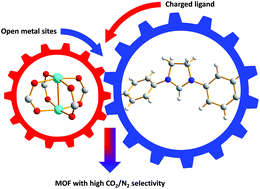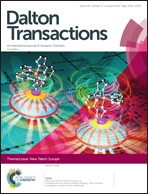Selective CO2 adsorption by a new metal–organic framework: synergy between open metal sites and a charged imidazolinium backbone†
Abstract
Metal–organic frameworks (MOFs) are porous, tunable crystalline materials that are attracting widespread scientific attention for their potential use in post-combustion CO2 capture. In this work, we report the synthesis of a new ligand, 1,3-bis(4-carboxyphenyl)-4,5-dihydro-1H-imidazol-3-ium tetrafluoroborate, H2Sp5-BF4, that is subsequently used for the construction of a novel MOF, Cu-Sp5-EtOH. This highly crystalline material has a charged framework that is expected to give rise to high CO2/N2 selectivity. However, the pores of the parent structure could not be accessed due to the presence of strongly coordinated ethanol molecules. After solvent exchange with methanol and subsequently heating Cu-Sp5-MeOH under vacuum, we are able to liberate the solvent providing other small molecules like CO2 access to the inside of the now porous structure, Cu-Sp5. The combination of open metal sites and framework charge leads to an exceptionally high CO2/N2 selectivity, as determined by Ideal Adsorbed Solution Theory (IAST) calculations performed on single-component adsorption isotherms. The CO2/N2 selectivity of Cu-Sp5 reaches a value of over 200 at pressures typically found in post-combustion flue gas (0.15 bar CO2/0.85 bar N2), a value that is among the highest reported to date.

- This article is part of the themed collection: New Talent: Europe


 Please wait while we load your content...
Please wait while we load your content...